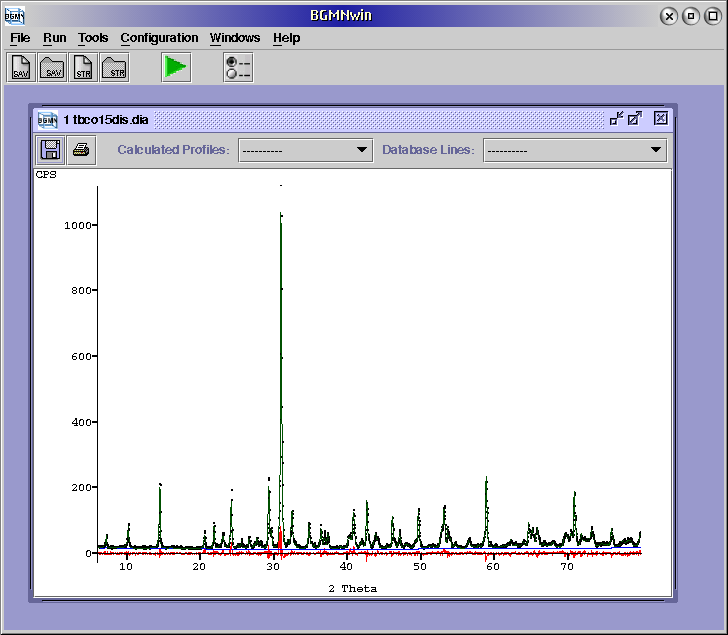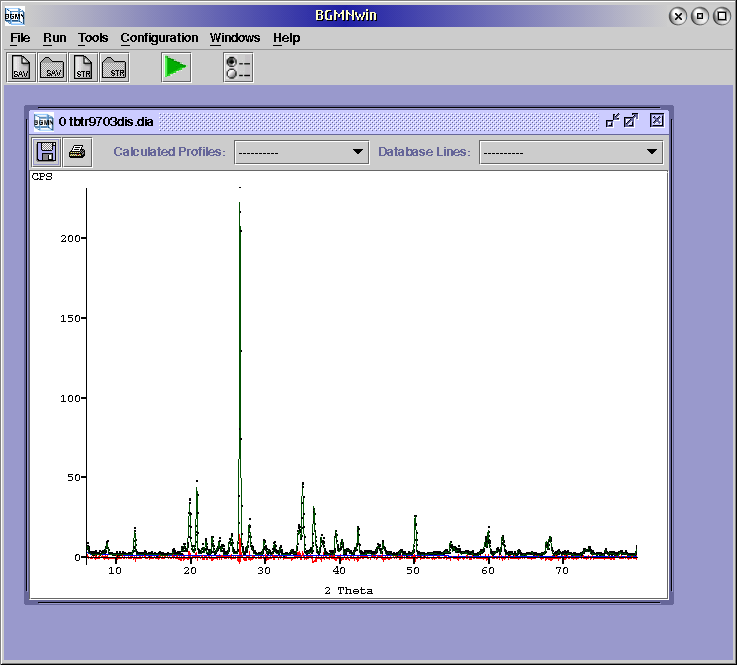
|
 |
 |
 |
 |
 |
 |
 |
BGMN Application:
Reference Sample Metashale Böhlscheiben
|
- Author:
-
Dr. R. Kleeberg
- Aim of this work:
-
This standard rock sample examined well was selected in order to test
the convergence behavior of the BGMN program on a real sample with several
low symmetrical phases and to compare different measuring geometry.
- Measurements:
-
The measurements were carried out at a sample of particle fraction
<30µm (step by step ground and sieved) both in Bragg-Brentano geometry
(reflection, URD 6) and in Debye-Scherrer geometry (transmission through flat
sample, XRD 3000 TT). For the case of transmission measurement, the measurement
parameters (goniometer radius, slits, sample thickness, step width, counting
time) were chosen so that a resolution sufficient for qualitative phase
analysis was reached. Pulse statistics and peak profiles useful for normal
peak search programs were still achieved in spite of smaller intensities
compared to reflection geometry (see fig. 2). Consequently, the measuring
time was in contrast to HILL et al. (1993) in the order of magnitude of the
"normal" measurements in reflection geometry.
- Calculation:
-
Refinement was carried out with muscovite as a 2M1-polytype
as above, chlorite (ripidolite) 1MIIb and albite with isotropic width
model and complex texture correction as well as with quartz. The difference
curve of first refinement showed weak remaining peaks at 0.324 nm. That
corresponds to a small potassium feldspar content presumed already in former
times already. Therefore, microcline (without texture modeling and with
limited peak broadening) was included in the model during the second
refinement.
- Results: (recalculated using BGMNwin on December 2005)
-
Table 1: Quantitative analysis results for metashale Böhlscheiben
| Phase |
STARKE (1969) |
RIETVELD reflection |
RIETVELD transmission |
| wt% |
wt% |
wt% |
| quartz |
30 |
31 |
32 |
| muscovite |
39 |
41 |
40 |
| chlorite |
19 |
18 |
17 |
| albite |
10 |
7 |
8 |
| microcline |
- |
1 |
1,5 |
| rutile |
- |
<1 |
<1 |
| accessories |
2 |
- |
- |

Fig. 1: Measurement and difference curve for metashale Böhlscheiben,
reflection geometry
Co Kα radiation, Fe filter, URD 6, 5°-80° 2Θ,
step width 0.03°, 5s per step

Fig. 2: Measurement and difference curve for metashale Böhlscheiben,
transmission geometry, CuKα radiation, graphite monochromator,
XRD 3000 TT, 6°-80° 2Θ, step width 0.04°, 10s per step.
The results in table 2 show good agreement for both types of measuring
geometry. In this case, the analyses seem to predict systematically more
quartz and muscovite as well as less chlorite compared to the recommended
values of STARKE (1969).
For the interpretation of these deviations, reliable estimates of the model
errors are still missing.
In the difference diagrams, the better modeling of the I00l
of muscovite in transmission geometry is noticeable. Polarization effects on
the mica crystallites textured strongly would be able to be cause for poor
modeling the 00l reflection intensities.
References
- Bergmann, J., Kleeberg, R., Taut, T., 1994:
A new structure refinement and quantitative phase analysis method basing on
predetermined true peak profiles.
Z. f. Kristallographie, Supplement issue No. 8, Europ. Cryst. Meeting 15, Book
of Abstracts p. 580.
- Bergmann, J., Kleeberg, R.,Taut, T., Haase, A., 1997:
Quantitative Phase Analysis Using a New Rietveld Algorithm - Assisted by
Improved Stability and Convergence Behavior.
Adv. X-Ray Analysis 40 (1997).
- Hill, R.J.; Tsambourakis, G. and Madsen, I.C., 1993:
Improved petrological modal analysis from X-ray powder diffraction data by
use of the Rietveld method
I. Selected igneous, volcanic and metamorphic rocks.
Journal of Petrology, 34, Part 5, p. 867-900.
- Starke, R., 1969:
Bestimmung der mineralischen Zusammensetzung des Tonschiefers TB durch
quantitative Phasenanalyse.
Berichte deutsch. Ges. geol. Wiss. B. Mineral. Lagerstättenforsch.
14 p. 73-77.

















